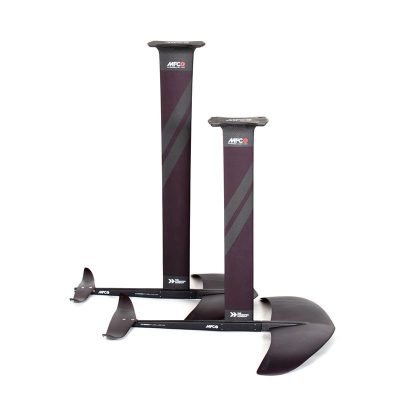

When you purchase gear through links on our site, we may earn a small commission. Here’s why you can trust our tests and our affiliate partner.

MFC (Maui Fin Company) was established in 1986. The company is world famous for its decade of windsurf fins engineering, designing fins for the finest athletes and brands. Today MFC Hawaii is focusing on developing big wave surfing fins with the best surfers in the world and is now applying its enviable R&D heritage to the world of hydrofoiling, and the HYDROS has been designed with one goal in mind: to make the most advanced surf foil to date. The design, the quality of construction and the ultra-light weight (less than 3kg) makes you feel that you have a high-end, state of the art piece of performance kit in your hands. Mast and fuselage are molded in carbon fiber and epoxy G33 bio resin. The mast is 70cm, has a really thin profile and is one solid piece with an integrated pedestal mount. The fuselage has a ‘conic’ front wing and mast attachment (where the wing sits over the fuselage) to provide a precise fitting. Fuselage and mast are joined with two M6 screws with a hexagonal headset. The front wings are molded with a PVC core/carbon and G33 epoxy bio resin, and the wings are designed with a compact delta outline and a V- double concave shape with a super narrow profile. They mount on the fuselage very satisfyingly with the conic attachment and are secured with two M6 bolts. The back wing is a full carbon V shape that is shimmed with one of the three shims included: Zero, 1.5 or 2.5.
We ran the test with a KT Drifter 4´10, 35 liter board in waves from 3 to 6 foot. Rider weight was 86kgs. For paddling, you feel like you’re on a surfboard. The foil has no drag at all in the water and you don’t feel that uncomfortable feeling of paddling with a fishing net that you get on thicker wing profiles. It moves smoothly in the water, and duck diving is predictable and easy. On the pop up, the foil is really gentle. You can take your time and adjust your trajectory easily, everything is stable and easy to control. In steeper surf you don’t get that horrible feeling of having to brace the nose like you can on other foils, and everything is impressively easy to control.
Once you are up and riding the lift is gradual and easy to control at speed. You can use your bodyweight naturally without forcing it to control the foil, which is really enjoyable and enables you to feel like the foil is a natural extension of your body. The HYDROS are predictable and there’s no need to adjust your position all the time as can be the case on other foils with more play, but it is clear as soon as you build speed that this this is a foil with obvious ‘performance pedigree’ as it generates huge acceleration and speed. Despite the speed, however, the HYDROS stays relatively easy to adjust and carve with the foil entering easily into the curve, and you can push on it as hard as you want and it is instantly responsive. Coming out of a carve and the foil feels comfortable and controlled: you can really focus on the next maneuver with flow and balance, instead of just ‘surviving’! The glide is really smooth and you can connect long flat sections without pumping at all. The drag is imperceptible, and the foil is 100% silent with the really thin wing profile keeping the foil really stable and easy to control, especially close to the surface. When the wing ventilates, the V shape concentrates the air streams through the concaves and sends it quickly to the trailing edge, keeping the glide going where many other foils would stall. It is really fun to carve this thing and recover angles you would never think about. Both of the wings we had on test could be pumped although the 1250 was (unsurprisingly) not so easy; you need to keep good speed but as soon as you have the right momentum it flies without effort. Then the 1400 is super nice to pump. Connecting the next wave is easy, and the distance of the glide will really save your legs…
We rode with all three shims over the course of the test and they made a significant difference to the performance characteristics of the foil. With the zero shim, the foil provides a really controllable lift and went really, really fast (we tried this with a kite too and it outperformed many kite-specific foils). On the 1.5 shim the foil is more responsive, easier to pump, enters the carve more comfortably and has more power on the front foot. Then the 2.5 shim provides tons lot of lift and responsiveness which was good for weak conditions and for impressively tight carves.